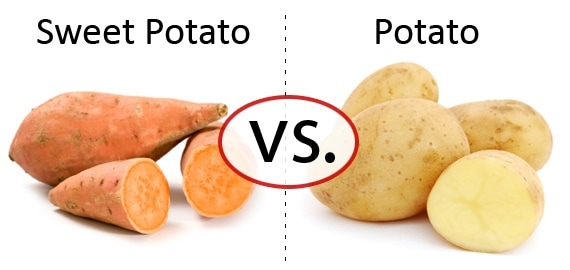
Written By: Sofia Layarda, MPH
Title: Master of Public Health
Alumni: University of California, Berkeley
Last Updated on:


To celebrate Nutrition Month, we thought we would have a little fun and do a faceoff comparing two vegetables. Here we take a closer look at two tubers that, despite their names, are actually completely unrelated.
Table of Contents
| Sweet Potato | Potato | |
| Serving Size: | 1 cup baked, skin on | 1 cup baked, skin on |
| Calories: | 180 kcal | 188 kcal |
| Fat: | 0.3 g | 0.3 g |
| Protein: | 4 g | 4.2 g |
| Total Carbohydrates: | 41.4 g | 42.2 |
| Fiber: | 6.6 g | 4.2 g |
| Potassium: | 950 mg | 1088 mg |
| Vitamin A: | 128% DV | <1% DV |
| Vitamin C: | 65% DV | 42% DV |
| Vitamin B6: | 29% DV | 21% DV |
We have to hand it to sweet potato for its high level of Vitamin A. It should be noted, though, that both sweet potato and regular potato are great choices as long as you consume them in the least processed way. This means buying them whole and unpeeled, scrubbing them well, then baking (or steaming), and consuming them with their skin on to maximize the nutrient load. Avoid boiling because some phytonutrients are water-soluble and would be lost in the cooking water.
Alumni: University of California, Berkeley – Sofia believes in bringing back fun and pleasure into everyday eating. She loves cooking, and is constantly experimenting with ingredients, creating recipes and trying them out on family and friends. Her latest interest lies in finding realistic and practical ways of environmentally-friendly food/eating habits.
food faceoff, grocery aisle, nutrition faceoff, potatoes, sweet potatoes, vegetables